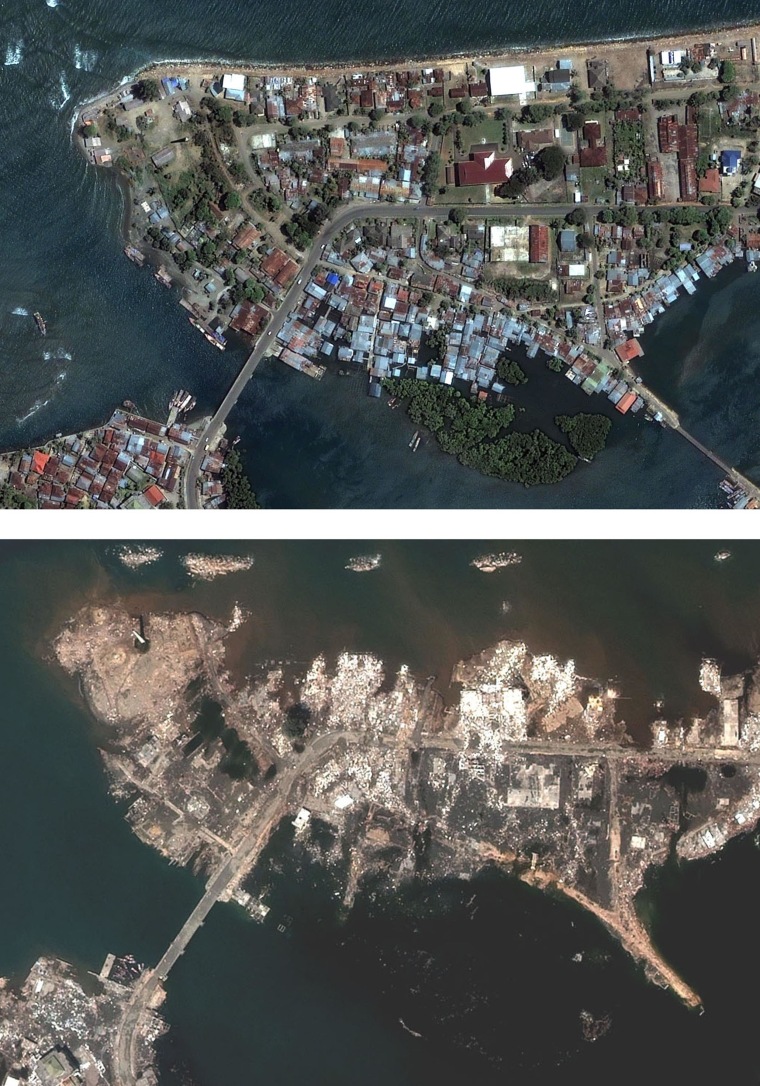Banda Aceh, Indonesia — Ten years after one of the most devastating natural disasters in recorded history, the city of Banda Aceh bears few scars from the day the Indian Ocean filled its streets. But for the residents of this town on the western Indonesian island of Sumatra, the memories are still as raw as a decade ago.
Gunawan Husny, an Acehnese fisherman, was at sea on Dec. 26, 2004, when a 9.1 magnitude earthquake struck 155 miles off of Banda Aceh. The quake triggered a powerful tsunami that smashed into the shorelines of 14 countries, demolishing towns and killing more than 230,000 people around the region. No area, though, was as badly hit as Banda Aceh.
Husny watched the 100-foot tsunami wave slam into the Sumatran coast. The force of impact as water tore through cement, trees and flesh was devastating.
The now-63-year-old fisherman rushed back to Banda Aceh to search through the rubble and makeshift refugee camps for his family. Husny would learn that 26 members of his family — including his wife, son and daughter — were among the estimated 167,000 residents of Banda Aceh who died in the tsunami.
Husny’s eldest daughter, Suci Landon, was his only child to survive: she'd been in Bali, working with the International Red Cross. Ten years later, she vividly remembers the chilling warning that greeted her when she landed at the Banda Aceh airport two days after the tsunami.
"The words welcoming us were, 'What are you guys doing? Go back, go back, go back!'" Landon recalled of those first moments in Aceh. "[They said] 'This is hell. This is the end of the world.'"
Landon had no word on what had happened to her family, but worked with the Red Cross assisting in the reunification of other broken families across Aceh. Finally, a man came to the Red Cross offices saying someone had seen her father in town.
"This is one moment that I will never forget," Landon tearfully told NBC News. “When I saw him and I hugged him the first thing I said was 'Where’s my mother?' then, 'Where’s my brother and sister?'"
"I think it was the lowest moment of my life, and then he said 'Suci, let it go,'" Landon added.
While residents in Aceh were scrambling to find loved ones and basic staples like food and water, word slowly trickled out about the extent of the damage and foreign aid organizations scrambled to send in assistance.
Michael Bäk was the first American to arrive in Aceh as part of USAID's Indonesia disaster response team — and nothing could have prepared him for the utter destruction he would find.
"This is hell. This is the end of the world"
"It was as if you’d taken a large eraser and erased the shoreline, the coastline," Bäk said. "There were more bodies than you could believe, that you could imagine. Stacked like timber on the side of the road."
"The images stay with you for a long time," he added.
One day, Bäk was approached by a U.S. Navy doctor from the USS Abraham Lincoln, which was providing disaster relief to Aceh. The doctor asked Bäk what culturally appropriate toy could help bring smiles to the traumatized children he was treating daily. Bäk suggested stuffed animals.
"The next morning, bright and early, a young officer from the ship comes up, salutes me and says, 'Mr. Bak I’ve been told to report to you,'" Bäk recalled to NBC News. "With him were several other servicemen carrying five huge plastic bags full of stuffed animals."

The night before, that Navy doctor had returned to his ship and organized an announcement for the 4,000-plus crew on board calling for donations of stuffed animals — which many had brought with them as reminders of their own children. The next day the crew was able to hand out hundreds of bears to wounded and sick Acehnese children.
"It was probably the best operation that navy ship ever did," Bäk said. "It was truly inspiring."
Looking at Aceh 10 years later, Bäk said some unexpected silver linings have come out of the tsunami's tragedy — including bringing to an end a nearly 30-year fight between separatists and the government in the region.
"I think Aceh has a lot to be proud of. They resolved a conflict, they rebuilt from one of the most dramatic natural disasters and they've opened themselves up to the world when they were very closed before," Bäk said.
Ashari Juned, a young father of two, was filmed by NBC News in the aftermath of the tsunami. This week in Banda Aceh he animatedly demonstrated how he'd clung to a fence as the ground shook beneath him and only let go to grab his five-day-old daughter and 2-year-old son to flee the coming wave. He made it to the top of a taller building where he watched the tsunami hit, sweeping away people into an angry swirl of debris.
“There was nothing to do for those people in the water, just watch,” Ashari recalled. Today, he and those around him have rebuilt — but not forgotton. His daughter — then an infant — is now a smiling 10-year-old. And her nickname? 'Nami — after the wave that forever changed their lives.